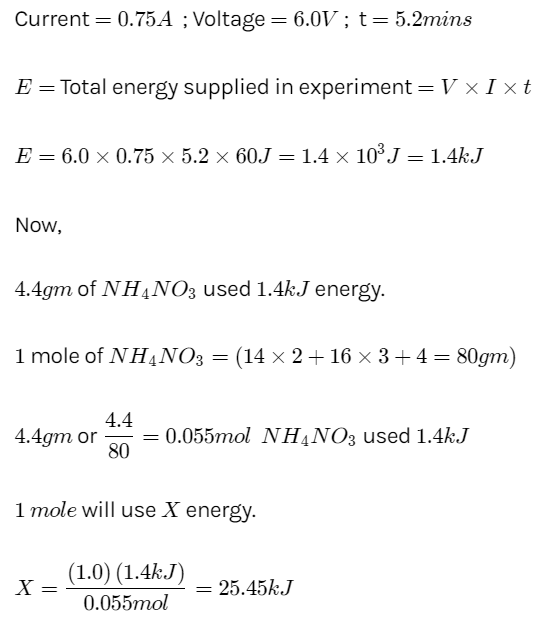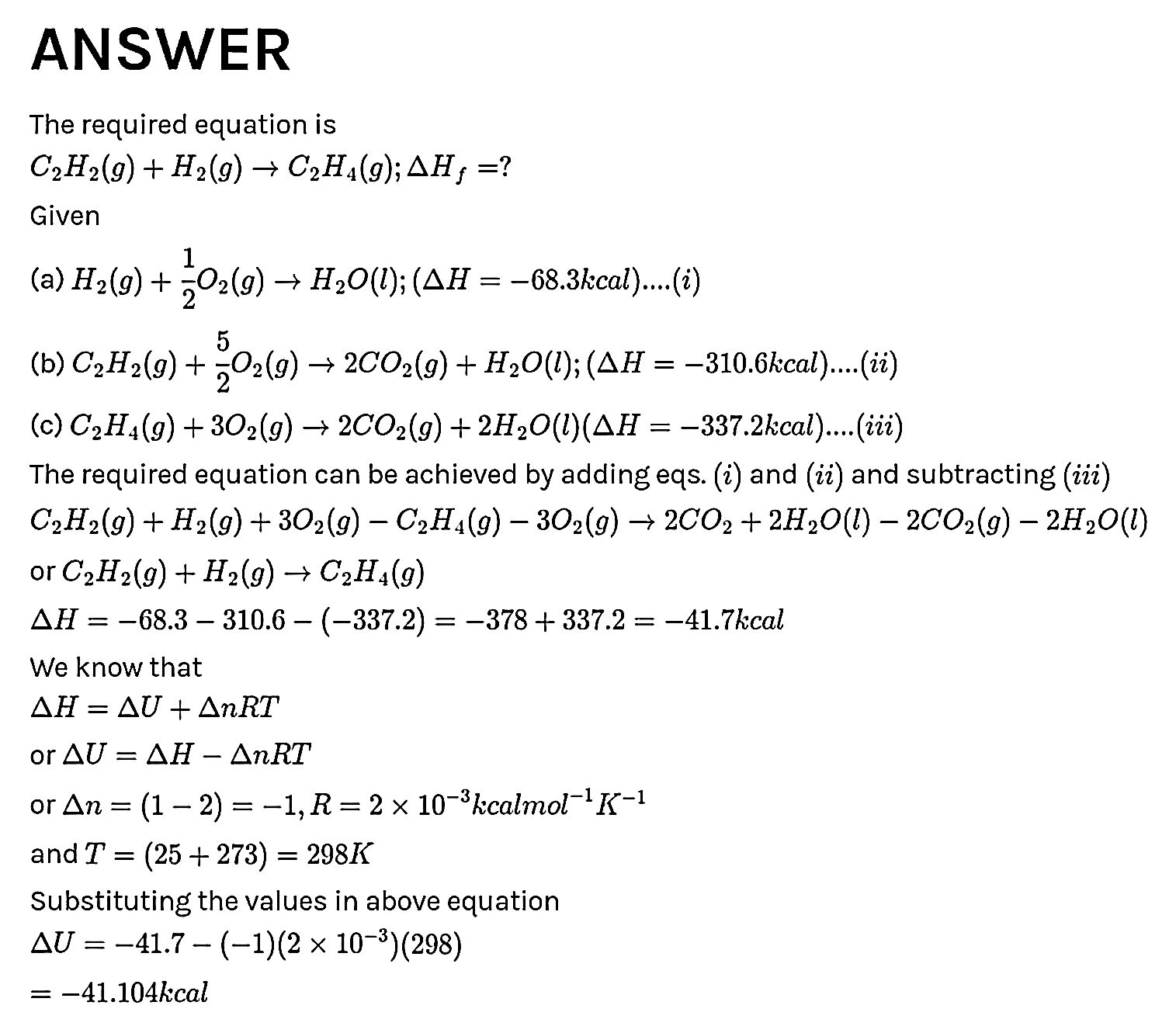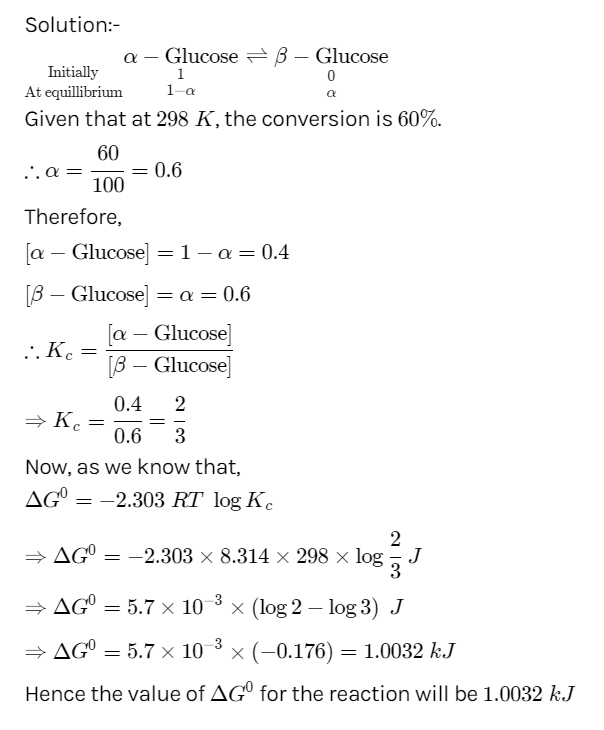Thermodynamics - Class 11 Engineering Chemistry - Extra Questions
Total internal energy of a system can never be evaluated but the change in internal energy can be determined by 1st law of thermodynamics.If true enter 1, else enter 0.
Write mathematical equations of first law of thermodynamics for the following processes :
(a) Adiabatic process (b) Isochoric process
What is Gibb's Energy?
The thermal capacity of calorimeter system is $$17.7\ kJ$$ $${K}^{-1}$$. ($$R=8.313\ {mol}^{-1}{K}^{-1}$$) (only magnitude in nearest integer in kJ/mol)
For a given reaction, energy of activation for forward reaction $$(E_{af}) \: is \: 80kJ.mol^{-1} .\Delta H =-40kJ.mol^{-1}$$ for the reaction. A catalyst lowers $$E_{af} \: to \: 20 \: kJ.mol^{-1}$$ . Find out the ratio of energy of activation for reverse reaction before and after addition of catalyst.
First law of thermodynamics is not adequate in predicting the spontaneity of process.
If true enter 1, else enter 0.
What is the relationship between $$\Delta G, \ \Delta H \ \& \Delta S$$?
Calculate $$\Delta { G }^{ o }$$ for the following reaction:
$$CO(g)+\cfrac { 1 }{ 2 } { O }_{ 2 }(g)\longrightarrow { CO }_{ 2 }(g);\Delta { H }^{ o }=-282.84kJ\quad $$
Given, $${ S }_{ { CO }_{ 2 } }^{ o }=213.8J{ K }^{ -1 }{ mol }^{ -1 },{ S }_{ CO(g) }^{ o }=197.9J{ K }^{ -1 }{ mol }^{ -1 },{ S }_{ { O }_{ 2 } }^{ o }=205.0J{ K }^{ -1 }{ mol }^{ -1 }$$
The standard enthalpy and entropy changes for the reaction in equilibrium for the forward direction are given below:
$$CO(g)+{ H }_{ 2 }O(g)\rightleftharpoons C{ O }_{ 2 }(g)+{ H }_{ 2 }(g)$$
$$\Delta { H }_{ 300K }^{ o }=-41.16kJ{ mol }^{ -1 }$$
$$\Delta { S }_{ 300K }^{ o }=-4.24\times { 10 }^{ -2 }kJ{ mol }^{ -1 }$$
$$\Delta { H }_{ 1200K }^{ o }=-32.93kJ{ mol }^{ -1 }$$
$$\Delta { S }_{ 1200K }^{ o }=-2.96\times { 10 }^{ -2 }kJ{ mol }^{ -1 }\quad $$
Calculate $${K}_{P}$$ at each temperature and predict the direction of reaction at $$300K$$ and $$1200K$$, when $${ P }_{ CO }={ P }_{ { CO }_{ 2 } }={ P }_{ { H }_{ 2 } }={ P }_{ { H }_{ 2 }O }=1$$ atm at initial state.
$${ C }_{ 2 }{ H }_{ 4 }+{ Cl }_{ 2 }\longrightarrow { C }_{ 2 }{ H }_{ 4 }{ Cl }_{ 2 }$$
$$\Delta H=-270.6kJ\quad { mol }^{ -1 };\Delta S=-139J{ K }^{ -1 }$$
(i) Is the reaction favoured by entropy, enthalpy both or none?
(ii) Find $$\Delta G$$ if $$T=300K$$
In a process 701 J of heat is absorbed by a system and 394 J of work is done by system. What is the change in internal energy for the process?
How much energy is required to change $$2\ Kg$$ of ice at $${0}^{0}C$$ into water at $${20}^{0}C$$? (specific latent of heat of fusion of water = $$3,34,000J/Kg$$, specific heat capacity of water = $${4200}\ {J}{Kg}^{-1}{K}^{-1}$$).
State and explain the first law of thermochemistry.
Law of conservation of energy is also known as ........
List I and List II contains four entries each. Entries of Column I are to be matched some entries of List II. One or more than one entries of List I may match with the same entry of List II.
List I lists the partial derivatives and List II lists the thermodynamic variable.
A slice of banana weighing 2.502 g was burnt in a bomb calorimeter producing a temperature rise of $$3.05^{\circ}C$$. The combustion of 0.316 g of benzoic acid in the same calorimeter produced a temperature rise of $$3.24^{\circ}C$$. The heat of combustion of benzoic acid at constant volume is $$-3227 \: kJ \: mol^{-1}$$. If the average banana mass is 125 g, the kilojoules of energy can be obtained from 1 average banana is: (nearest integer value)
Calculate the enthalpy change for the reaction (only magnitude in nearest integer in kj/mol):
$$2C(s)+2{H}_{2}(g)+{O}_{2}(g)\longrightarrow {CH}_{3}{CO}_{2}H(l)$$
What are the characteristics of free energy $$(G)$$?
The enthalpy of combustion of glucose is $$-2808kJ\quad { mol }^{ -1 }$$ at $${ 25 }^{ o }C$$. How many grams do you need to consume. (Assume $$wt=62.5kg$$)
(a) to climb a flight of stairs rising through $$3M$$
(b) to climb a mountain of altitude $$3000M$$?
Assume $$25$$% of enthalpy can be converted to useful work.
A sample of $$0.16\ g\ CH_{4}$$ was subjected to the combustion at $$27^{o}C$$ in a bomb calorimeter. The temperature of the calorimeter. The temperature of the calorimeter system (including water) was found to rise by $$0.5^{o}C$$. Calculate the heat of combustion of methane at
(i) constant volume and
(ii) constant pressure. the thermal capacity of calorimeter system is $$17.0\ kJ\ K^{-1}$$ and $$R=8.314\ J\ K^{-1}\ mol^{-1}$$
The specific heats of iodine vapour and solid are $$0.031$$ and $$0.05$$ cals/g respectively. If heat of sublimation of iodine is $$24$$ cals/g at $${ 200 }^{ o }C$$.
Calculate its value at $${ 250 }^{ o }C$$.
If 1.0 k cal of heat is added to 1.2 L of $$O_2$$ in a cylinder of constant pressure of 1 atm, the volume increases to 1.5 L. Calculate $$\Delta H$$ and $$\Delta U$$ of the process.
Give reasons :
Thermodynamically an exothermic reaction is sometimes not spontaneous.
For the synthesis of ammonia at 300 K:$$N_2(g) +3H_2(g) \rightarrow 2NH_3(g)$$
Calculate the value of the $$\Delta G^0$$ in Kcal and give your answer in magnitude by using the following data:
$$N_2$$ $$H_2$$ $$NH_3$$
$$\Delta H^0_{f} (kcal/mole)$$ 0 0 -10
$$S^0(Cal/K-mole)$$ 40 30 45
The heat of solution of $$NH_{4}NO_{3}$$ in water was determined by measuring the amount of electrical work needed to compensate for the cooling which would otherwise occur when the salt dissolves. After the $$NH_{4}NO_{3}$$ was added to the water, electrical energy was provided by the passage of current through a resistance coil until the temperature of the solution reached the value it had prior to the addition of salt. In a typical experiment, $$4.4\ g$$ of $$NH_{4}NO_{3}$$ was added to $$200\ g$$ water. A current of $$0.75$$ ampere was provided through the heater coil, and the voltage across the terminals was $$6.0\ V$$. The current was applied for $$5.2$$ minute. Calculate $$\Delta H$$ for the solution of $$1.0$$ mole $$NH_{4}NO_{3}$$ in enough water to give the same concentration as was attained in the above experiment.
Given below are some standard heats of reaction;
(a) Heat of formation of water $$=-68.3\ kcal$$
(b) Heat of combustion of acetylene $$=-310.6\ kcal$$
(c) Heat of combustion of ethylene $$=-337.2\ kcal$$
Calculate the heat of reaction for the hydrogenation of acetylene at constant volume at $$25^oC.$$
Calculate pH at which the following conversion (reaction) will be at equilibrium in basic medium $$I_2(s) \rightarrow I^-(aq)+IO_3^-(aq)$$ when the equilibrium concentrations at 300K are $$ [I^-]=0.10 M$$ and $$ [IO_3^-]=0.10 M$$
[Given that $$\Delta G ^0_f(I^-,aq)=-50 kJ/mole, \Delta G^0_f(IO_3^-,aq)=-123.5 kJ/mole, \Delta G^0_f(H_2O,l)=-233kJ/mole$$
$$\Delta G^0_f(OH^-,aq)=-150kJ/mole$$ ideal gas constant=$$R=\dfrac{25}{3}Jmole^{-1}K^{-1}, log_e10=2.3$$]
$$\alpha- D$$ glucose undergoes muta rotation to $$β-D$$ glucose in aqueous solution. If at $$298 K$$ there is $$60\%$$ conversion. Calculate $$\Delta G^o$$ for the reaction.
What is specific heat capacity?
Class 11 Engineering Chemistry Extra Questions
- Chemical Bonding And Molecular Structure Extra Questions
- Classification Of Elements And Periodicity In Properties Extra Questions
- Environmental Chemistry Extra Questions
- Equilibrium Extra Questions
- Hydrocarbons Extra Questions
- Organic Chemistry - Some Basic Principles And Techniques Extra Questions
- Redox Reactions Extra Questions
- Some Basic Concepts Of Chemistry Extra Questions
- Some P-Block Elements Extra Questions
- States Of Matter Extra Questions
- Structure Of Atom Extra Questions
- Thermodynamics Extra Questions


